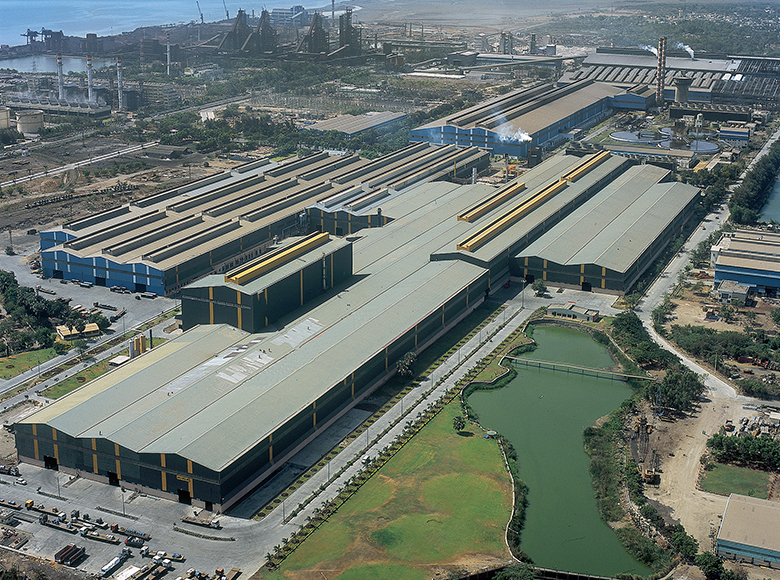Far-reaching: Essar Steel’s complex in Hazira, India
An insolvency court decision in India this week could have far-reaching consequences for public-sector bank restructuring, the distressed debt market, and the overall appetite of international funds for Indian credit.
The ruling concerns Essar Steel India, the most high-profile bankruptcy in the country.
The handling of this case is being seen as a litmus test for India’s ambitions to increase the speed of resolution of a host of failed businesses that are dragging down the books of India’s many public-sector lenders.
Essar is being sold to ArcelorMittal, meaning that creditors will get some of their money back.
However, in a ruling that few saw coming, the National Company Law Appellate Tribunal (NCLAT) has decided that secured creditors won’t be treated any differently than unsecured creditors. The holding of collateral apparently won’t make any difference to the way the creditors are reimbursed.
The entire CIR process with respect to the corporate debtor being one of the largest non-performing assets of the country has been put under jeopardy
– Consortium of lenders
Whether this is good or bad obviously depends on your position. Most of the secured lenders are state-owned banks; most of its operational creditors, or unsecured creditors, are vendors and suppliers.
Standard Chartered, for example, had unsecured exposure through a loan to a subsidiary of Essar Steel, and had been looking at getting 2% of its claim back.
However, other lenders, ranging from State Bank of India (SBI) to specialist foreign distressed credit firms such as Hong Kong’s SC Lowy, had been expecting to get as much as 90% back. Now, instead, everyone will get about 60.7%.
“In the resolution plan, 0% of [operational creditor] debt has been proposed to be paid, whereas the financial creditors have been proposed to be paid 92.5% of their dues and claims,” said the appellate tribunal.
“We modify the plan to safeguard the rights of the operational creditors and other financial creditors.”
The knock-on effects of this ruling are numerous.
|
Narendra Modi, |
The establishment of a more streamlined court process for insolvency and bankruptcy was a key reform of Indian prime minister Narendra Modi.
It was supposed to unclog the banking system and, by resolving bad debts, free public-sector banks to start lending again, which in turn was supposed to kick-start the economy, especially in the small and medium-sized business sector.
Cases that used to be mired in the courts for years were to be subject to a limit of 270 days for resolution. In fact, Essar Steel has passed 600, but that would have been forgiven if it had given a clear indication of a functioning system that could be finessed in due course.
Now, though, nothing is certain.
Essar Steel will at least be resolved, but the fact that big Indian public lenders such as SBI will be getting back much less than they expected means that, if the same principle is used in all recoveries, they will not be rebuilding their balance sheets and freeing capital at the rate they expected to. That, in turn, affects how much they can lend.
Consequences
More broadly, international distressed debt investors are watching closely – and not just the ones with exposure to Essar. For more than a year now many international names have been waiting for the right moment to step in and start buying distressed assets. (Meanwhile, Kotak Mahindra, the smartest homegrown investment bank, has raised a fund ready to invest.)
However, this ruling may cause investors to keep their powder dry, or remove it from play completely.
It is usually considered an immutable law of finance that secured creditors rank ahead of unsecured creditors in a liquidation.
This has other consequences: banks lend at different interest rates for secured and unsecured exposures, to reflect the fact they ought to be better off in situations where they hold collateral.
Logically, if lenders in India feel that security doesn’t mean anything anymore, they will charge more for their loans.
The situation is also likely to repel foreign private equity and vulture funds. SC Lowy, for example, had bought its exposure from Bank of Baroda in expectation of the secured securities being made almost whole – or at least a lot better than the unsecured.
If that’s not the case, will they, and others like them, come back?
Groups including Deutsche Bank, Barclays and Credit Suisse have been hovering around looking for good opportunities. They are unlikely to be enthralled by this either.
There’s still a chance the ruling might be overturned. A consortium of lenders led by SBI has filed a petition before the Supreme Court against the ruling.
“The entire CIR [corporate insolvency resolution] process with respect to the corporate debtor being one of the largest non-performing assets of the country has been put under jeopardy,” the consortium stated.
India has always done things its own way, but there are times when it would be useful to be a little more predictable.
NOTE: Do you want to trade at forex professionally? trade with the help of our forex robots developed by our programmers.
Signal2forex reviews


 Signal2forex.com - Best Forex robots and signals
Signal2forex.com - Best Forex robots and signals




